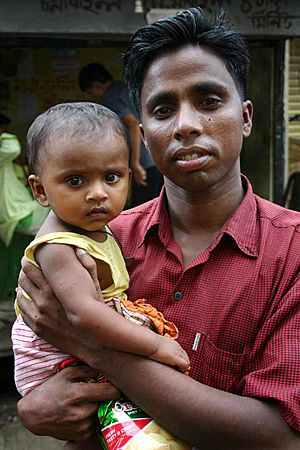Infant attachment facts for kids
Infant attachment is a very special bond that babies form. It's usually their first important relationship, often with their mother or parents. This bond helps babies feel safe and loved.
A psychologist named Mary Ainsworth studied babies in the 1960s and 70s. She found that babies can form different types of attachments. This often depends on how they were cared for when they were very young. These early experiences can shape how people expect relationships to be later in life. However, these early patterns don't completely decide how future relationships will turn out.
Being a baby is a super important time for growing and learning. Babies grow physically, learn how to interact with others, and pick up life skills. For example, they learn what to eat and how to react if a predator is nearby.
It's also a key time for brain development. In mammals, some behaviors are already built into their brains. But many behaviors are just possibilities that need to be learned and developed. These include:
- Learning to understand what they see, hear, and feel.
- Setting up how their body works normally.
- Turning early experiences into patterns of behavior.
- Learning to see others in their group as individuals who feel and respond like them. Special brain cells called mirror neurons help with this.
Animals like primates, and especially humans, have bigger brains (specifically the neocortex). This means they have more complex ways of interacting socially. For babies, nursing (feeding from the mother) is a big part of this. It does four important things:
- It gives the baby food.
- It helps the mother and baby stay close for the baby's safety.
- It lets the baby watch and learn from its mother.
- The mother's milk gives the baby antibodies. These protect the baby from some infections until its own immune system is strong enough.
If a baby is part of a group of siblings (a litter), it plays with them. If it's a single baby, it will start playing with other young animals nearby. This happens when the mother can still quickly help if needed.
Staying close is important for nursing. Being close helps with social interaction, and social interaction is key for survival. Attachment happens in many mammals, but it's much stronger in humans. In the past, mothers often carried their babies or left them with another trusted adult, like a grandmother or older sibling. This way of raising children has been part of our biology for a long time. Only in recent history, especially in the last 60 years, has this pattern changed a lot.
Contents
What is Infant Attachment?
Most of the time, a baby's main caregivers are their mother and father. When parents respond to a baby's cries with kindness, the baby learns that they will be cared for. If parents smile, talk, sing, and hold the baby even when it's not crying, the baby learns that it is loved.
When a baby learns it is loved and will be cared for, it often grows up expecting others to be kind. A child who feels loved and cared for, and expects others to be nice, is called securely attached.
Why is Attachment Important?
Attachment is a special system that helps social animals, like humans, survive and grow. During babyhood, important patterns of behavior are set. These patterns become the foundation for all future relationships.
At first, attachment helps protect the baby. But soon, its main purpose becomes supporting the baby's brain development. It also helps the baby's body systems work well, and supports social and emotional growth and learning. Attachment is found in all mammals to some degree, but it's much more developed in humans. It's a behavior system that's present at birth, but it needs to be activated and developed through care and interaction.
Who Developed Attachment Theories?
Two important people who thought and wrote about attachment theory were John Bowlby and Mary Ainsworth.
Bowlby's Ideas on Attachment
John Bowlby believed that the care and love a baby gets from its parents help it form a very important idea. He called this idea the internal working model. This model is how a baby or child thinks about themselves, their parents, and other people.
When parents lovingly care for a baby, the child grows up with a positive internal working model. This child will think they are lovable because they were loved. They will think their parents are good because they were caring. And the child won't be afraid to make new friends, because they will expect people to be nice. Children with a positive internal working model are also likely to be kind to others. Bowlby thought that a positive internal working model would help people make friends easily.
Bowlby also believed that the attachment process in humans was similar to the close bonds between mother and baby chimpanzees, gorillas, and orangutans. He thought that attachment in people develops slowly, in four steps.
Ainsworth's Research on Attachment
Mary Ainsworth studied how mothers treated their babies in different cities and countries. She noticed that many ways mothers and babies acted were the same, even if their lives were very different.
Ainsworth created a special way to test the attachment relationship between a mother and her young child. She called this test "The Strange Situation."


